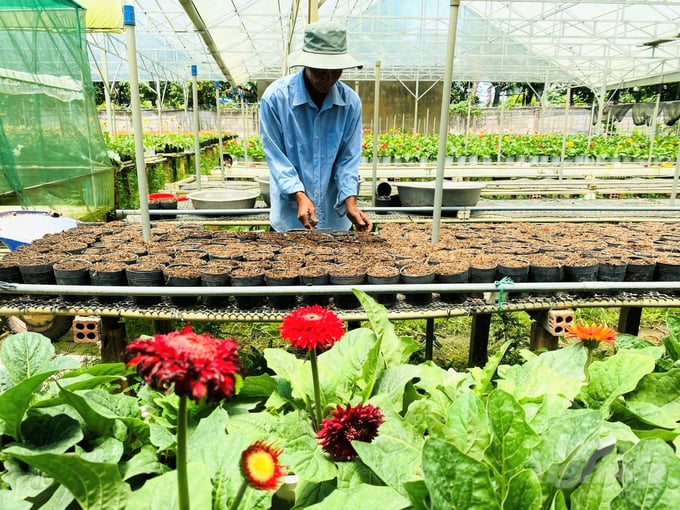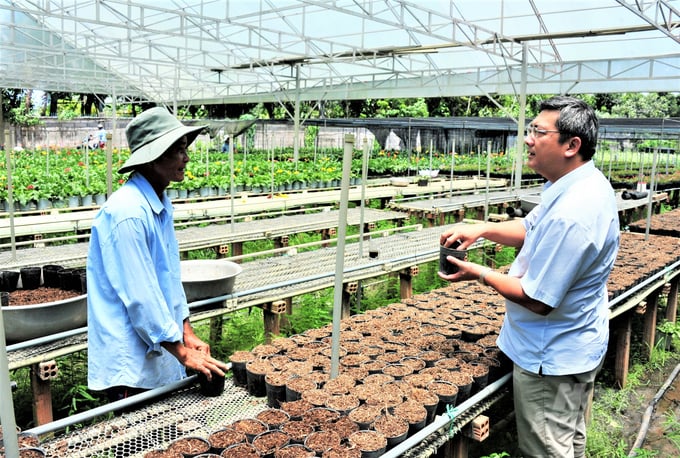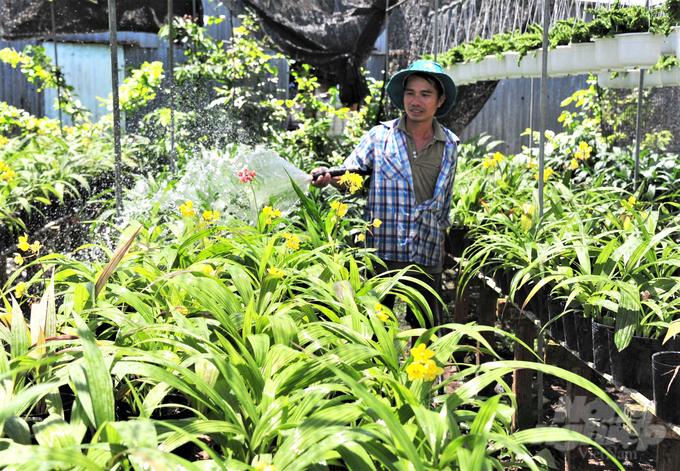May 31, 2025 | 03:20 GMT +7
May 31, 2025 | 03:20 GMT +7
Hotline: 0913.378.918
May 31, 2025 | 03:20 GMT +7
Hotline: 0913.378.918
Tan Quy Dong Ornamental Flower Cooperative (Tan Quy Dong ward, Sa Dec city) was established in 2003 and consolidated in 2007 with 101 members. The charter capital contribution is VND 187 million VND, and the total business capital of the Cooperative is more than VND 1 billion. The Cooperative provides 8 services to members, including Selling supplies for the ornamental flower industry (pots, coconut bran, cow manure...), selling fertilizers and pesticides, linking ornamental flower consumption and internal credit, selling plants and flower seeds, storing necessities (rice, sugar, noodles, fish sauce...), technical consulting and project design.
In recent years, in addition to developing members' flower and ornamental plant-growing professions, the Cooperative has gradually increased the number of services according to members' needs. To date, the Cooperative has provided 7 services and plans to ask the general meeting of members for 2 more services next year.

Tan Quy Dong Ornamental Flower Cooperative provides many services to members at lower prices than the market and links with ornamental flower consumption, creating stable output. Photo: Hoang Vu.
In addition, the Cooperative focuses on improving the quality of three traditional business services: selling supplies for the ornamental flower industry, fertilizers and pesticides, and linking consumption. The Cooperative signs a contract to grow ornamental flowers at the request of domestic businesses, redistributing them to increasing members. The Cooperative gradually expanded more services to meet the needs of its members.
The participation of many cooperative members in the model of Sa Dec Flower Village Assembly Hall and Ward Farmers' Association to share knowledge and experience in growing ornamental flowers, combining cooperative member households with many years of experience in flower growing. Applying scientific and technical advances has helped the cooperative's products not only be present in the Mekong Delta provinces but also reach Ho Chi Minh City, Dong Nai, Binh Duong, Central provinces, Central Highlands, and some North provinces... and exported to countries such as Laos, Cambodia, Thailand, and China.

Dr. Tran Minh Hai (right), Vice Principal of the School of Public Policy and Rural Development, surveyed Tan Quy Dong ornamental flower cooperative within the framework of the topic "Research and propose solutions to build the model New-style agricultural cooperatives operate effectively in Dong Thap province." Photo: Hoang Vu.
The cooperative always has many new varieties of ornamental flower products, meeting the market's diverse needs. In particular, within the framework of the project "Research and propose solutions to build a new model of agricultural cooperatives that operates effectively in Dong Thap province" implemented by the School of Public Policy and Agricultural Development, the cooperative was allowed by the school to test "super hydrophilic seeds" used in growing ornamental flowers.
Regarding the link to develop tourism with Sa Dec Flower Village, the cooperative's strategy will be to connect with travel companies and flower viewing attractions in Sa Dec Flower Village to connect tours for tourists.
Tan Quy Dong Ornamental Flower Cooperative is one of 16 cooperatives that Dong Thap province chose to develop advanced cooperatives and build an ornamental flower brand. At the annual members' congress for the 2020-2023 term, the cooperative strives to achieve billions of VND in revenue, supply 150,000 seedlings, and mobilize capital to support members from VND 1 - 1.2 billion. Every year, 5-10 new members are admitted.

In a cooperative that produces ornamental flowers, members do not worry about output but can rest assured that they have good quality products. Photo: Hoang Vu.
Mr. Tran Thanh Xuan, from Tan My cluster, Tan Quy Dong ward, a member of Tan Quy Dong Ornamental Flower Cooperative, confided that his family has a tradition of producing ornamental flowers. Since getting married, my parents gave me 2,000 square meters to pursue this family business. At first, I only produced traditional ornamental flowers to sell to neighboring provinces. Still, during Tet, I also left about 400-500 square meters for planting ornamental flowers to sell at Tet markets.
The main thing in cooperatives is that ornamental flower producers do not care about output but can rest assured that they produce good product quality. As for seeds, fertilizer inputs, baskets, flower pots, straw manure, sawdust, planting techniques, etc., the cooperative cooperates with partners to supply members at prices ranging from equal to lower than the market price. At the end of the season, members of the Cooperative selling ornamental flowers will pay the money back to the cooperative.

Dr. Tran Minh Hai (right), Vice Principal of the School of Public Policy and Rural Development, presented a package of "super water-storing seeds" to Tan Quy Dong Ornamental Flower Cooperative for testing in growing ornamental flowers, reducing the number of watering times, reduce labor. Photo: Hoang Vu.
In addition, Sa Dec also improves the quality of ornamental flower products and mobilizes qualified households to participate in developing more community tourism models. Sa Dec is encouraging business establishments to invest in facilities and form entertainment spots and services combined with tourism.
Sa Dec focuses on building and developing agriculture step by step to develop urban, modern, and sustainable agriculture with the strength of developing ornamental flowers. Thereby, it is planned to build Sa Dec Ornamental Flower Village to become the largest concentrated flower production area in the Mekong Delta, combined with developing tourism services associated with flower production areas.
Secretary of Dong Thap Provincial Party Committee Le Quoc Phong said that to promote Sa Dec flowers further, the province will organize the Sa Dec Flower Festival at the end of 2023, becoming a periodic activity. Organizing a flower festival will promote the pride of flower village people, expand the consumer market, and bring the image of flowers further to have more opportunities for Sa Dec flowers.
Translated by Tuan Huy

(VAN) Several scientists and farmers are experimenting with soil treatment in some key durian-growing regions such as Cai Lay (Tien Giang), Dak Song, Gia Nghia, and Dak R’lap (Dak Nong).
/2025/05/25/4127-3-073637_820.jpg)
(VAN) Thanks to the promotion from an FAO-implemented project, vegetable production in greenhouses in Moc Chau has seen strong development, from 1.5 hectares in 2021 to nearly 50 hectares in 2024.

(VAN) FAO has recently supported USD 140,000 to implement the project 'Risk mitigation human-animal interface risks through disease control initiatives in pig farming.'

(VAN) The People's Committee of Tra Vinh province has approved an adjustment to the investment policy for the Green Hydrogen Plant project, increasing its area to approximately 52.76 hectares.
![Reducing emissions from rice fields: [2] Farmers’ commitment to the soil](https://t.ex-cdn.com/nongnghiepmoitruong.vn/608w/files/news/2025/05/05/dsc08881jpg-nongnghiep-140632.jpg)
(VAN) Clean rice cultivation model in Thuong Tan commune, Bac Tan Uyen district, is assisting local residents in achieving sustainable agriculture by substantially reducing costs, increasing productivity, and protecting the environment.

(VAN) At the conference to disseminate Resolution No. 68, AgriS introduced its digital agricultural ecosystem and reaffirmed its commitment to accompanying the Government in promoting private sector development and sustainable agriculture.

(VAN) 'Blue Ocean - Blue Foods' initiative is designed to restore marine ecosystems and establish sustainable livelihoods for local communities by cultivating a minimum of 1,000 hectares of cottonii seaweed in the first three years.